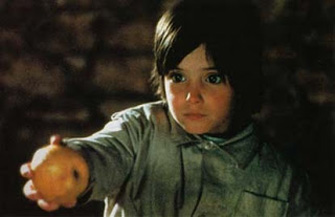Sole Criterion: The Spirit of the Beehive
By Brett Ballard-Beach
November 23, 2012
Erice frames his tale somewhat as a fable early on and maintains that air with the rest of the film, which though not viewed exclusively through Ana’s eyes, could be said to come from a child’s (or at least more innocent, less cynical) state of mind. The music by Luis de Pablo is built around simple melodies and simple instrumentation (a pan flute figures in the opening/closing credits theme) but which contain a bent towards the melancholy. During the opening credits, a series of about a dozen crude color drawings are displayed which, when considered in retrospect - I watched the film twice over consecutive nights - lay out some of the plot elements and key visual motifs of the story. The film also begins with an intertitle “Once upon a time . . .”
Erice was in his early 30s when making the film and was born the year that it is set. He directed half a dozen short films in the decade before The Spirit of the Beehive and the same number between 1993 and 2010. The Spirit of the Beehive was his feature-length debut and the first of only three he has made to date (the others followed in 1983 and 1992.)
He grew up under the reign of dictator Francisco Franco, who seized power in the wake of the successful military rebellion during the Spanish civil war, and ruled until his death in 1975. The decades from the 1940s though the 1970s were marked by death or imprisonment for Franco’s enemies and accompanied by a heavy censorship for the arts. Erice relates an amusing anecdote of how his film, which while not overtly political, contains allegorical critique of the time in which it is set, managed to escape being cut or banned. The censorship board couldn’t find anything specific they disagreed with or found offensive, and let it off the hook, because they felt audiences would find it dull as they did and it wouldn’t attract attention. Forty years on, The Spirit of the Beehive remains one of the most acclaimed Spanish films of all time, both within its borders, and internationally.
Much of the film rests on the shoulders of Ana Torrent, the actress who portrays the heroine. Like the other family characters, Ana isn’t explained but presented and because much of her internal journey involves her relationship with the fantasy life she creates (which as stated isn’t dramatized or made visceral, save for a few instances), and because she doesn’t converse with others about this, her performance rests almost entirely in her eyes and in her posture. It reminds me of another great child performance, that of Victoire Thivisol (as a four-year old dealing with the loss of her mother) in the French film Ponette. Torrent was six at the time The Spirit of the Beehive was filmed and if nothing else, her visage was appropriately grave for the role and she found ways of reflecting the smallest nuances.
Cuadrado used a handheld camera just once during filming for the sequence in which Frankenstein is screened for the village and he and Erice managed to capture the reaction of Torrent upon seeing the moment where the monster and the young girl meet. In an occurrence of magical happenstance, it was precisely the reaction her character was supposed to convey. Like many other moments in the film, it is not oversold with a close up (and again, at that point in the film, we don’t know she is to be the lead character) and the subtlety can easily be missed.
Continued:
1
2
3
4
|
|
|
|




